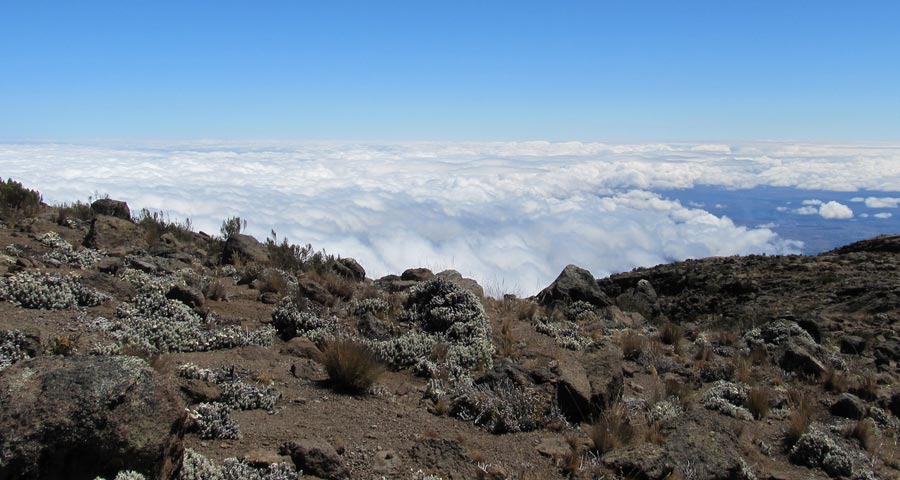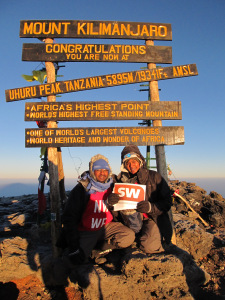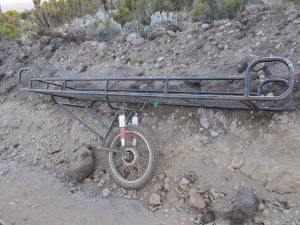I can’t quite explain exactly why I wanted to climb Mount Kilimanjaro.
I remember hearing about it, watching a program about it on TV and reading several articles. All of them pertaining to taking a rather long walk up a very large hill. To most, this is hardly the perfect holiday nor the most adventurous. But to me, it was a trip that I had wanted to take for half my life.
Having found my ultimate adventure buddy and partner in crime (my husband), I made the decision to attempt to tackle this ‘hill’ before I reached my 30th birthday. A milestone moment to mark a milestone birthday, what a lovely thought. And that’s pretty much as far as it got… But the process had been put in motion, albeit all in my mind, and it gave birth to a fiery determination to try and make the trip the following year.
My adventure buddy was up for the challenge too so off we went, all wide-eyed and full of awe, to a talk about climbing the mighty mountain. And what a talk it was (we mainly listened)! They gave us a detailed account of what would be required from start to summit, as well as all the bumps in-between. While the end result was to get us to book, they made sure to advise us on all the knarly bits which was greatly appreciated as I prefer having as much info as possible upfront. After ensuring we had enough funds for the trip (be warned, this is not cheap), we forged ahead and finalised the dates for our trip for September and confirmed our booking accordingly.
We planned to summit on the 9th of September 2014 as it would be a Full moon.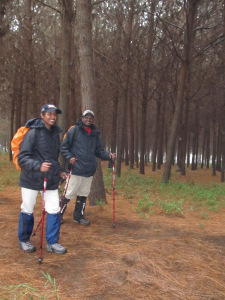 We then spent the next five months training by slowly building up our stamina and strength. There are many guidelines on what the best forms of exercise are to assist you in preparing for the climb, but ultimately, being able to walk and hike for hours at a time is the best training that you can do. People have successfully prepared for the climb in eight weeks, however, they had to follow strict and gruelling training schedules of at least two hours of training per day, six days a week with a hike of at least three hours on the seventh day. We chose to pace ourselves.
We then spent the next five months training by slowly building up our stamina and strength. There are many guidelines on what the best forms of exercise are to assist you in preparing for the climb, but ultimately, being able to walk and hike for hours at a time is the best training that you can do. People have successfully prepared for the climb in eight weeks, however, they had to follow strict and gruelling training schedules of at least two hours of training per day, six days a week with a hike of at least three hours on the seventh day. We chose to pace ourselves.
A friend of ours, who had successfully summited Kilimanjaro in 2013, advised us to climb stairs. Lots and lots of stairs. So that’s exactly what we did – we bought a stair machine! We combined this with yoga to stretch out our muscles and went for a hike every weekend. In the last two months before our climb, we also started hiking with weighted backpacks to simulate the conditions that we would be hiking in, as well as increased our hikes by doing back to back treks of at least five hours or more.
For the route that we had chosen, the most ground that we would cover in one day would be 18 kilometres, so we worked on ensuring we could cover that distance comfortably, and in so doing ensured we would be able to navigate the shorter stretches with ease.We already had most of the winter gear required for our climb from previous adventures so thankfully we did not need to fork out for all of that as well, as the gear on its own is quite costly. But when your gear is all that stands between yourself and the elements, it becomes a worthwhile investment that needs to be taken into account.
Come September, we were all prepped and ready to go! And extremely nervous…While we had spent our time productively preparing for the trek, there is only so much that you can do when faced with an obstacle called Acute Mountain Sickness (also known 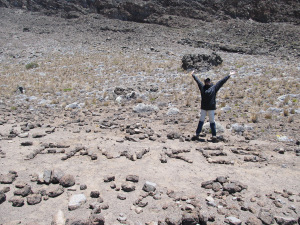 as altitude sickness/ AMS). This can affect even experienced climbers, and while certain precautions can be taken (drinking lots of water, pacing yourself, medication is available to help ease the effects) there is no guarantee that you will be less prone to it or suffer less from the symptoms. It’s the leveller that can hinder the most experienced explorers and flatten the newbies such as ourselves. The words of ‘encouragement’ that we received from some of our friends and family did nothing to comfort us (You only hiked 15
as altitude sickness/ AMS). This can affect even experienced climbers, and while certain precautions can be taken (drinking lots of water, pacing yourself, medication is available to help ease the effects) there is no guarantee that you will be less prone to it or suffer less from the symptoms. It’s the leveller that can hinder the most experienced explorers and flatten the newbies such as ourselves. The words of ‘encouragement’ that we received from some of our friends and family did nothing to comfort us (You only hiked 15
This can affect even experienced climbers, and while certain precautions can be taken (drinking lots of water, pacing yourself, medication is available to help ease the effects) there is no guarantee that you will be less prone to it or suffer less from the symptoms. It’s the leveller that can hinder the most experienced explorers and flatten the newbies such as ourselves. The words of ‘encouragement’ that we received from some of our friends and family did nothing to comfort us (You only hiked 15 kms today?! That’s not enough! You need to do 50 a day. / If you can’t run for 20 mins non-stop, you not ready to climb the mountain. / If you get frostbite – which toe would you prefer to lose?). So we started our climb filled with excitement and anxiety in equal measure.
There are five routes on Mount Kilimanjaro leading to the summit. The two most popular are the Marangu (Coca-Cola) and Machame (Whisky) routes. Both of these see climbers ascending and descending on the same route, and are also the two routes that all climbers descend on. There are then the Umbwe and Lemosho routes which ascend from the South Western quadrant of the mountain, with each later joining the Machame or Marangu routes for the second half of the climb and descent accordingly. The last trail is called the Rongai route which ascends from the North Eastern side of the mountain bordering Kenya and descends on the Marangu route. We chose to do the Rongai route, as it would allow us to see two different sides to the mountain as well as not repeat the same route going up as coming down.
To start our climb we needed to first be transported to the main gate at Marangu to sign in 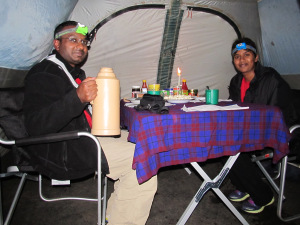 (our guide finalised all the paperwork and permits accordingly) and then travel by road for approximately two and half hours around the base of the mountain to the starting point for the trek which goes through the Rongai Forest. We then had time to relax while our guides and porters sorted out all the luggage and gear that was to be carried up the mountain. We were served a hearty lunch consisting of a hot cucumber soup, fried chicken, avocado sandwiches and fresh fruit before we began our trek at around 14h00. Very different from the other routes where climbers begin trekking first thing in the morning.
(our guide finalised all the paperwork and permits accordingly) and then travel by road for approximately two and half hours around the base of the mountain to the starting point for the trek which goes through the Rongai Forest. We then had time to relax while our guides and porters sorted out all the luggage and gear that was to be carried up the mountain. We were served a hearty lunch consisting of a hot cucumber soup, fried chicken, avocado sandwiches and fresh fruit before we began our trek at around 14h00. Very different from the other routes where climbers begin trekking first thing in the morning.
My husband and I were the only two climbers in our team (unfortunately none of our friends or family were interested in joining us on this adventure) and even though we were happy to have strangers join our group, there were no other takers for the same dates as ourselves who had booked through the same company. However, we were far from lonely. For every climber, there has to be an experienced guide who accompanies them up the mountain. We also had a cook who prepared all our meals, porters to carry all the baggage (our main luggage as well as the tents, mats, chairs, tables, cutlery, crockery, etc – our team were well prepared) and an extra man to carry the portable toilet that we hired for our climb. Altogether we had 12 people with us!
While our two guides stayed with us the whole time during our trek, the rest of the team 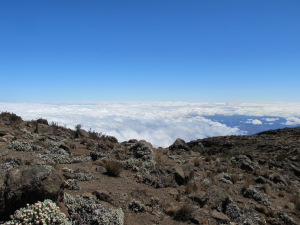 goes ahead to the campsites and begins to set up for that evening. Even though we did spend our trip camping, we were definitely taken care of and our team ensured that we were as comfortable as possible. We were served three hot meals a day and were also welcomed to the camp at the end of each day with fresh popcorn or roasted peanuts served with your choice of tea, coffee, milo or hot chocolate. We did not need to collect our daily drinking water either as the cook would refill our water bottles each day with water that had been boiled. However, we did take the extra precaution of using water purification tablets as well. Being first-time climbers we also decided to err on the side of caution and booked an extra night to acclimatise on the mountain at Mawenzi Tarn, which had been suggested to us by the Operator that we had booked through.
goes ahead to the campsites and begins to set up for that evening. Even though we did spend our trip camping, we were definitely taken care of and our team ensured that we were as comfortable as possible. We were served three hot meals a day and were also welcomed to the camp at the end of each day with fresh popcorn or roasted peanuts served with your choice of tea, coffee, milo or hot chocolate. We did not need to collect our daily drinking water either as the cook would refill our water bottles each day with water that had been boiled. However, we did take the extra precaution of using water purification tablets as well. Being first-time climbers we also decided to err on the side of caution and booked an extra night to acclimatise on the mountain at Mawenzi Tarn, which had been suggested to us by the Operator that we had booked through.
Following the advice of those who had gone before us, and listening to our Guides 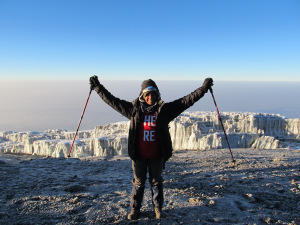 definitely paid off.
definitely paid off.
On the 9th of September 2014, after five and a half days of trekking, my husband and I successfully summited Mount Kilimanjaro, reaching Uhuru Peak at 06h15am. The elation and pride that we felt at the top, having achieved what we set out to do on our very first attempt, cannot be described in words – and that’s saying something as I’m not exactly short on vocabulary…!
My first view of the Uhuru Peak signpost will forever be etched in my mind – a large rustic looking wooden signboard perfectly sandwiched between a setting moon on the left and a rising sun on the right. And the views were breath-taking! Although I admit that could have been the short supply of oxygen at that altitude… Which is also why you don’t get to spend much time at the summit. Even our experienced guides admitted that they start to get headaches (one of the first signs of AMS) if they are at the summit for more than 20 minutes.
We were allowed approximately 10 minutes, just enough time to jostle for position at the sign (be prepared for a bit of a fight as its very busy at the top – we were surprised to see that many people there), snap a few pic’s of the Hans Meyer glacier (a permanent glacier at the top of the crater which has been steadily decreasing in size due to global warming) and of course a few pic’s of ourselves (most important!). You then begin to retrace your steps back down the mountain, first to your base camp (from where you departed the night before) and then onwards to the next campsite which for us was an approximate eight kilometres further down the mountain. We would then have spent one more night on the mountain, making our way out the gate the following day. If everything went according to plan…
Life does tend to throw you a curveball every now and then. For us, it was my husband experiencing problems breathing while we descended the mountain. Everything had been going fine on our descent up until we reached Stella Point which was when he started to notice that it was becoming painful for him to breathe. By the time we got to Gillman’s Point, it was apparent that it was only getting worse. We slowly made our way back to Kibo, which was our base camp for the night before, and our guides allowed us to rest for about three hours to see if that would help. Unfortunately, it was not getting better and the decision was made to evacuate him.
This was done Kili-style: he was cocooned in a sleeping bag and then strapped to a metal stretcher with a wheel which was then pushed down the mountain by porters and a park ranger to the next camp (I had to run after them playing catch-up). One of our guides were always with me and kept me posted on the progress regarding my husband, emergency services and our arrangements in town. Once we had reached Horombo Camp (where we would have spent the night) we were collected by the park emergency services vehicle and driven out to the park main gate. Our guides had
Our guides had liaised with the park as well as their company’s operations office in Moshi town to ensure that once at the gate, there was a vehicle waiting for us to take us to the hotel. Our additional night’s accommodation had also been arranged for us by the Operators head office and their head of operations met us at the hotel to make sure we were okay. My husband was already feeling much better by the time we had arrived at the hotel in Moshi. We were told that this was due to the ‘shake, rattle and roll’ of his trip down to Horombo Camp (which had him coughing up quite a bit of phlegm) as well as being back at a normal altitude.
He, therefore, opted not to go to the hospital that evening and rather to rest at the hotel, a decision which the guides agreed to as his vitals were all stable and we had a general antibiotic with us as well. We also made arrangements to meet the guides and all the porters at the hotel the next day to be able to thank them for all their hard work and helping to get us to the roof of Africa.
By the next morning, my husband was back to normal and it was me who was suffering! My legs were aching from chasing his stretcher down the mountain (I’ve never been a runner and after and it was me who was suffering! My legs were aching from chasing his stretcher down the mountain (I’ve never been a runner and after that, I don’t think my body is made for it either)! We capped off our trip with drinks with the whole team in the afternoon where we were also presented with our certificates for summiting Mount Kilimanjaro. All in all, it was a fantastic experience, one that I will never forget. I actually can’t wait to go back…although next time I’ll take the Kili-stretcher Thanks!
Tanisha Pillai
24 November 2014

